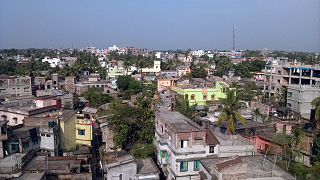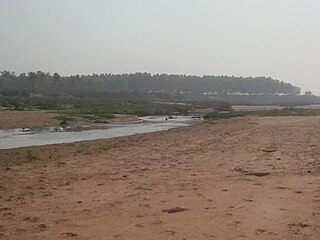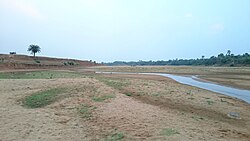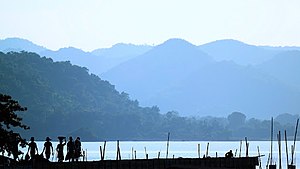
Birbhum district is an administrative unit in the Indian state of West Bengal. It is the northernmost district of Burdwan division—one of the five administrative divisions of West Bengal. The district headquarters is in Suri. Other important cities are Bolpur, Rampurhat and Sainthia. Jamtara, Dumka and Pakur districts of the state of Jharkhand lie at the western border of this district; the border in other directions is covered by the districts of Bardhaman and Murshidabad of West Bengal.

Rampurhat is a city and a municipality in Birbhum district in the Indian state of West Bengal. It is the headquarters of the Rampurhat subdivision. According to Census 2011 Rampurhat is the third most populous city in Birbhum district and 82nd most populous city in West Bengal. Rampurhat is a rapidly growing township It is near the West Bengal / Jharkhand border. Rampuhat is an important city of Birbhum district as it has dynamic connectivity with the other places of West Bengal and neighboring states via state highways, national highway and rail route. Rampurhat Junction is one of the busiest railway stations in eastern India.
Kandi is a sub-divisional town and a municipality in Murshidabad district in the Indian state of West Bengal. It is the headquarters of the Kandi subdivision and is located on the east bank of Kana Mayurakshi River. It is also known as the rice store of Murshidabad district, owing to its large production of rice. It is situated 30 km away from Berhampore, the district headquarter of Murshidabad and approximately 195 km from Kolkata, the capital of West Bengal.
Nalhati is a town and a municipality in Rampurhat subdivision of Birbhum District in the Indian state of West Bengal near the West Bengal / Jharkhand border. This town is named after the Shakti peeth Nalhateshwari temple, which according to the mythologies is situated where the "nala" i.e. throat of goddess Shakti had fallen. It is one of the 51 Shakti Peethas in India. Nalhati Municipality was established in 2000.

Suri Sadar subdivision is an administrative subdivision of Birbhum district in the state of West Bengal, India.
Panagarh–Morgram Highway runs from the junction with NH 19 at Panagarh Darjeeling Mor to NH 12 at Morgram. It passes through Kanksa, Ilambazar, Hetampur, Dubrajpur, Suri, Rampurhat, Nalhati and Lohapur. It is mostly a two lane highway with a total length of 171 kilometres (106 mi). Panagarh to Suri is 71 kilometres (44 mi) and Suri to Morgram is 100 kilometres (62 mi).Panagarh to Rampurhat distance is 120Km and Morgram to Rampurhat is 35 Km The Dubrajpur-Morgram sector is part of NH 14 and the Dubrajpur-Panagarh sector is part of SH 14.

The Hinglo River is a tributary of the Ajay River in the Indian states of Jharkhand and West Bengal.

The Bansloi River is a tributary of the Bhagirathi.

The Dwarka River is a tributary of Bhagirathi.

The Brahmani River is a tributary of the Dwarka River.
Mayureswar is a village and gram panchayat in Mayureswar II CD Block in Rampurhat subdivision of Birbhum district in the Indian state of West Bengal.
Hansan is a village and a gram panchayat in Rampurhat II CD Block in Rampurhat subdivision of Birbhum district in the Indian state of West Bengal

Massanjore Dam is a hydropower generating dam over the Mayurakshi River located at Massanjore near Dumka in the state of Jharkhand, India. The Massanjore dam, across the Mayurakshi, was commissioned in 1955. It was formally inaugurated by Lester B. Pearson, Foreign Minister of Canada. The Mayurakshi River at the dam site has a catchment area of 1869 km2
Paikar is a village in the Murarai II community development block in the Rampurhat subdivision of Birbhum district in the Indian state of West Bengal.
Chakmandala is a village in Rampurhat I CD Block in Rampurhat subdivision of Birbhum district in the Indian state of West Bengal
Basoa is a village in Rampurhat II CD Block in Rampurhat subdivision of Birbhum district in the Indian state of West Bengal
Kotasur is a census town in Mayureswar II CD Block in Rampurhat subdivision of Birbhum district in the Indian state of West Bengal. It is situated in the bank of river Mayurakshi..
Satpalsa is a village in Mayureswar II CD Block in Rampurhat subdivision of Birbhum district in the Indian state of West Bengal.
Lokpara is a village in Mayureswar II CD block in Rampurhat subdivision of Birbhum district.
Madian is a village in Mayureswar I CD block in Rampurhat subdivision of Birbhum district.











